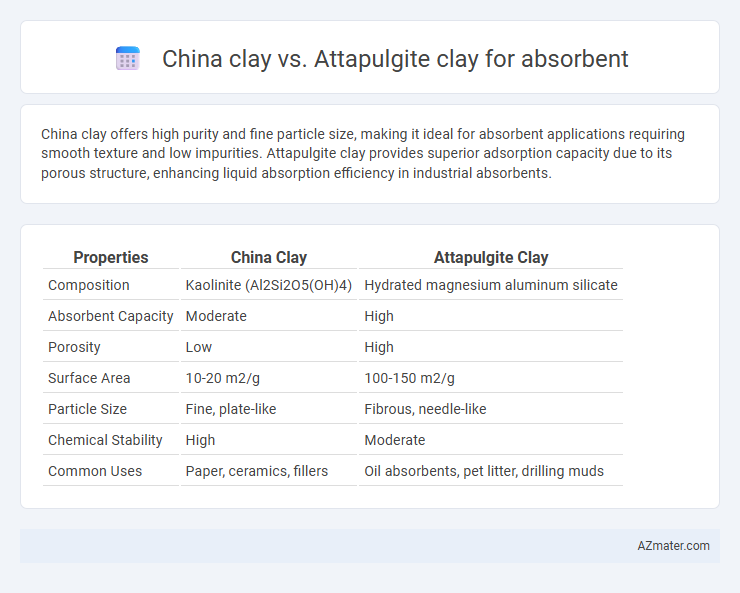China clay offers high purity and fine particle size, making it ideal for absorbent applications requiring smooth texture and low impurities. Attapulgite clay provides superior adsorption capacity due to its porous structure, enhancing liquid absorption efficiency in industrial absorbents.
Table of Comparison
| Properties | China Clay | Attapulgite Clay |
|---|---|---|
| Composition | Kaolinite (Al2Si2O5(OH)4) | Hydrated magnesium aluminum silicate |
| Absorbent Capacity | Moderate | High |
| Porosity | Low | High |
| Surface Area | 10-20 m2/g | 100-150 m2/g |
| Particle Size | Fine, plate-like | Fibrous, needle-like |
| Chemical Stability | High | Moderate |
| Common Uses | Paper, ceramics, fillers | Oil absorbents, pet litter, drilling muds |
Introduction to Absorbent Clays
Absorbent clays such as China clay (kaolin) and Attapulgite are widely used for their high adsorption capacities and fine particle structure. China clay offers excellent water absorption and is rich in alumina and silica, making it ideal for filtration and purification applications. Attapulgite clay, distinguished by its unique fibrous crystal structure, provides superior oil and chemical absorbency, making it valuable in environmental cleanup and industrial spill control.
Overview of China Clay (Kaolin)
China clay, also known as kaolin, is a fine, white clay primarily composed of the mineral kaolinite, widely used for its high absorbency and chemical inertness. It exhibits excellent moisture absorption qualities, making it ideal for applications in industries such as paper coating, ceramics, and pharmaceuticals. Unlike attapulgite clay, which has a fibrous structure and higher adsorption capacity, kaolin's smooth, plate-like particles provide superior absorbency for liquids and oils in various industrial and environmental uses.
Overview of Attapulgite Clay
Attapulgite clay, also known as palygorskite, is a naturally occurring magnesium aluminum silicate that excels in absorbent applications due to its high surface area and fibrous structure. It offers superior oil and moisture absorption compared to China clay (kaolin), making it ideal for industrial absorbents, pet litter, and environmental cleanup. Its unique layered and porous composition enhances adsorption capacity and retention, distinguishing it from the more plate-like structure of China clay.
Physical Properties Comparison
China clay (kaolin) exhibits fine particle size and high plasticity, resulting in excellent water absorption but moderate oil absorption. Attapulgite clay features a needle-like crystal structure with a higher specific surface area, providing superior adsorptive capacity and improved oil retention. The physical differences in particle morphology and porosity between China clay and Attapulgite clay critically influence their effectiveness as absorbents in various industrial applications.
Absorbency Performance: China Clay vs Attapulgite
Attapulgite clay exhibits superior absorbency performance compared to China clay due to its unique fibrous structure and higher porosity, which enhances liquid retention and swelling capacity. China clay, primarily kaolin, has lower absorbency but offers better brightness and smooth texture, making it less effective in high-demand absorbent applications. Industries requiring efficient moisture management prefer attapulgite for products like cat litter, oil absorbents, and pharmaceuticals because of its enhanced absorption rate and capacity.
Chemical Composition Differences
China clay, also known as kaolin, primarily consists of the mineral kaolinite with a chemical formula of Al2Si2O5(OH)4, featuring a layered silicate structure that provides moderate absorbent properties. Attapulgite clay, composed mainly of magnesium aluminum silicate with the formula (Mg,Al)2Si4O10(OH)*4(H2O), has a fibrous morphology and a higher surface area, enabling superior absorption of liquids and oils. The key chemical difference lies in kaolin's aluminum silicate layers versus attapulgite's chain silicate structure, resulting in distinct pore sizes and absorption capacities suitable for varied industrial applications.
Industrial Applications and Uses
China clay, primarily composed of kaolinite, excels in industrial applications requiring high whiteness and fine particle size, making it ideal for paper coating, ceramics, and rubber fillers. Attapulgite clay, known for its unique fibrous structure and high absorptive capacity, is extensively used in oil and chemical spill clean-ups, drilling mud formulations, and as an absorbent in detergents and animal litter. The superior adsorption properties of attapulgite make it more suitable for moisture and toxin absorption, whereas china clay's smooth texture benefits surface finishing and filler materials.
Environmental Impact and Safety
China clay, primarily composed of kaolinite, exhibits low environmental toxicity and is widely used in eco-friendly absorbents due to its inert nature and minimal chemical reactivity. Attapulgite clay offers superior absorbent properties with a high surface area and porosity but raises environmental concerns because of potential heavy metal contamination and slower natural degradation. Safety profiles favor China clay as it generally lacks harmful impurities, whereas Attapulgite requires careful handling and monitoring to mitigate risks associated with inhalable dust and trace toxic elements.
Cost and Availability Analysis
China clay, also known as kaolin, offers widespread availability due to extensive mining operations in countries like China and the USA, making it a cost-effective option for absorbent applications. Attapulgite clay, mined primarily in the southeastern United States, is typically more expensive due to limited deposits and higher processing costs despite its superior absorption and gel-forming properties. The decision between these clays depends on balancing lower procurement costs of China clay against the enhanced performance but higher price point of attapulgite clay in absorbent products.
Conclusion: Choosing the Right Clay for Absorbency
China clay, known for its fine particle size and high purity, excels in applications requiring smooth texture but offers moderate absorbency compared to Attapulgite. Attapulgite clay provides superior absorbent properties due to its unique fibrous structure and high surface area, making it ideal for industrial spill control and oil absorption. Selecting between China clay and Attapulgite depends on specific absorbency needs, with Attapulgite favored for high-performance absorbent products.

Infographic: China clay vs Attapulgite clay for Absorbent
 azmater.com
azmater.com